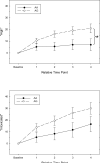A polymorphism in GABRA2 is associated with the medial frontal response to alcohol cues in an fMRI study
- PMID: 20698837
- PMCID: PMC4154567
- DOI: 10.1111/j.1530-0277.2010.01293.x
A polymorphism in GABRA2 is associated with the medial frontal response to alcohol cues in an fMRI study
Abstract
Background: Significant evidence has accumulated to suggest an association between single-nucleotide polymorphisms (SNPs) in the GABRA2 gene and alcoholism. However, research has yet to show an association between these polymorphisms and the human brain's reward system function. In this study, we stratified subjects who had participated in an fMRI study of alcohol cue responses according to their genotype at a SNP in GABRA2 (rs279871) shown to be associated with alcohol dependence (Edenberg et al., 2004).
Methods: Genotyping showed 13 subjects to be homozygous for the high-risk allele (AA), and 23 subjects to be heterozygous (AG). In fMRI, subjects were exposed to the aromas of their preferred alcoholic drink odors (AO), as well as to appetitive control odors (ApCO) under both alcohol intoxication and placebo control conditions.
Results: Homozygous AA subjects had a larger [AO > ApCO] response than did AG subjects in medial frontal cortical areas thought to code reward value. However, AG subjects had a larger [AO > ApCO] effect in the ventral tegmental area. Alcohol intoxication did not alter these group differences.
Conclusions: These are the first data to suggest that GABRA2 genotype could affect the brain's responses to cues associated with alcohol.
Copyright © 2010 by the Research Society on Alcoholism.
Figures




References
-
- Agrawal A, Edenberg HJ, Foroud T, Bierut LJ, Dunne G, Hinrichs AL, Nurnberger JI, Crowe R, Kuperman S, Schuckit MA, Begleiter H, Porjesz B, Dick DM. Association of GABRA2 with Drug Dependence in the Collaborative Study of the Genetics of Alcoholism Sample. Behavior Genetics. 2006;36:640–650. - PubMed
-
- Boehm SL, II, Ponomarev I, Jennings AW, Whiting PJ, Rosahl TW, Garrett EM, Blednov YA, Harris RA. γ-Aminobutyric acid A receptor subunit mutant mice: new perspectives on alcohol actions. Biochemical Pharmacology. 2004;68:1581–1602. - PubMed
Publication types
MeSH terms
Substances
Grants and funding
LinkOut - more resources
Full Text Sources
Other Literature Sources

